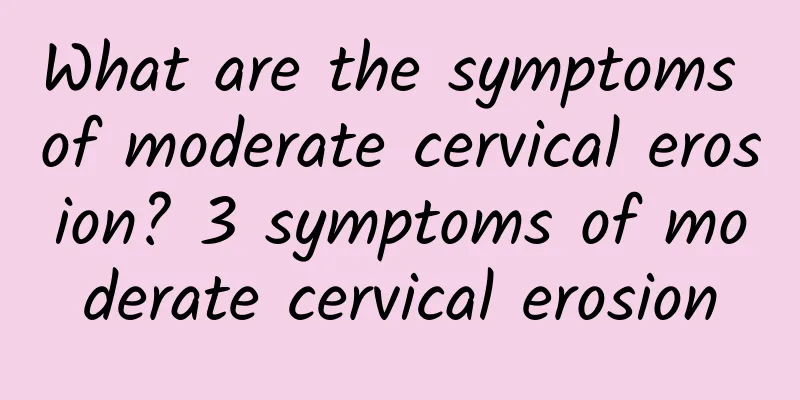Typical symptoms of threatened miscarriage are

|
Typical symptoms of threatened abortion include a small amount of vaginal bleeding and discomfort such as lower abdominal pain or backache. If these symptoms occur, you should seek medical attention in time, check to determine the condition, and take appropriate measures to treat and preserve the fetus. Delaying treatment may increase the risk of abortion. 1. Slight vaginal bleeding One of the most common symptoms of threatened abortion is a small amount of vaginal bleeding, which may appear as brown discharge or bright red bleeding. This usually occurs in the first trimester, and the amount of bleeding is usually small, but the duration varies. Vaginal bleeding may be caused by abnormal embryo development, endometrial damage, or corpus luteum insufficiency. If bleeding is found, you should go to the hospital for an ultrasound examination as soon as possible to find out whether the embryo is developing and the fetal heart rate is normal. 2. Lower abdominal pain and backache Threatened abortion may also cause lower abdominal pain, a feeling of heaviness or lower back pain. Some women describe this feeling as similar to menstrual discomfort. Although the symptoms are mild, they may indicate uterine contractions, abnormal embryo implantation or other potential problems. To reduce the risk, pregnant women need to rest and try to avoid strenuous activities. At the same time, doctors may recommend the use of antispasmodics, such as magnesium sulfate or progesterone, to relieve uterine contractions. 3. Other discomfort symptoms In addition to the typical symptoms mentioned above, threatened abortion may be accompanied by the sudden disappearance of pregnancy symptoms such as nausea or breast tenderness. This may indicate that the embryo has stopped developing. You should pay special attention to the appearance of such symptoms and seek medical attention as soon as possible. Ultrasound tests can be performed to understand whether the embryo is alive and the situation in the uterus so that the doctor can take further treatment measures. If the embryo has stopped developing, a uterine curettage may be required. Treatment and prevention recommendations: Once typical symptoms appear, it is recommended to rest in bed immediately and go to the hospital as soon as possible to find out the cause. For confirmed threatened abortion, the doctor may take treatment measures according to the specific cause, such as progesterone replacement therapy using progesterone injection, dydrogesterone tablets, uterine spasm-relieving drugs and pregnancy-preserving treatment. In terms of diet, you can increase protein and vitamin intake such as lean meat, eggs, dark green vegetables, etc., and avoid cold and irritating foods. If you feel anything unusual during pregnancy, don't worry too much, but you need to seek medical evaluation as soon as possible to avoid worsening of the condition and affecting the health of the fetus and pregnant woman. |
<<: Gynecological Bartholin's gland cyst symptoms
>>: What are the symptoms of endometritis and pelvic inflammatory disease?
Recommend
Causes of abdominal pain after abortion
Many patients experience abdominal pain after abo...
Detoxification diet promotes metabolic health and helps you lose weight
The relationship between the human body and calor...
What treatments are most effective for cervical warts?
Many skin and sexually transmitted diseases appea...
How much does it cost to treat endometrial thickening?
How much does it cost to treat endometrial thicke...
How much does it cost to treat irregular menstruation?
How much does it cost to treat irregular menstrua...
Several serious hazards of cervical erosion
As a gynecological disease with great harm, cervi...
Can massage cure irregular menstruation?
Can massage cure irregular menstruation? Irregula...
Things to note when self-diagnosing ectopic pregnancy
What are the main self-diagnosis methods for ecto...
What to eat to lose weight faster? Get ready for these 15 great weight loss foods!
It’s hot summer again, and everyone is crazy abou...
What is the reason for menstruation after amenorrhea?
What happens when menstruation comes back after a...
What is the effect of Bartholinitis during pregnancy on the fetus?
Does Bartholinitis during pregnancy have any effe...
Be careful when having an abortion: the dangers of multiple abortions
Women who have experienced multiple abortions wil...
Best treatment for endometrial tuberculosis
Endometrial tuberculosis is tuberculosis of the e...
Thousands of people plant rice in 2 hectares of rice fields to challenge the Guinness World Record
Taiwan's rice is of excellent quality. Domest...
Taiwan Green Gold! Taro-flavored edamame is available in December
After 10 years of selection and breeding, the Cou...









